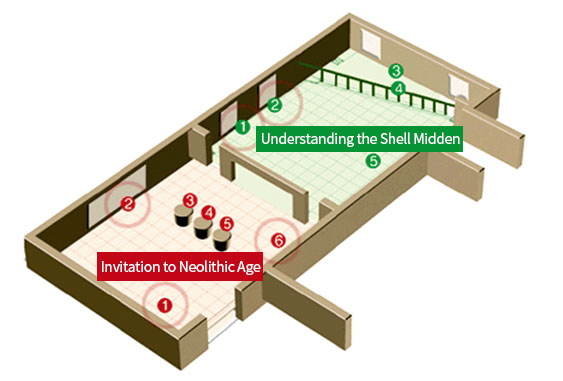
| Invitation to Neolithic Age | Understanding the Shell Midden |
|---|---|
1. Culture of Neolithic Age 2. Historical Sites and Distribution of Neolithic Age 3. Neolithic Culture of Busan |
1. Dongsam-dong Shell Midden
2. What is a shell mound? |

From 12,000 years ago Paleolithic Age, which lasted for few million years ended and the Neolithic Age, which uses the stone tools and pottery living in a settlements, began.
Unlike Paleolithic Age the people of Neolithic Age lived together around the seashore, riverside or hills which have an abundant water supply and foods. They lived along through hunting, fishing and collecting wild plants. Also from 5000 years ago they started a primitive farming which mainly cultivated millets, etc.
Through these lifestyles Neolithic people left various types of dwelling sites, tombs and shell mound. Through various types of artifacts excavated here such as, comb-patterned pottery, stone tools, bone tools, jewelry and ceremonial instruments we can peek at their daily lives.
There are approximately 300 historical sites of Neolithic Age which have been found and investigated in Korea until now. The types of historical sites are such as, shell mound, dwelling sites, tombs, caves and outdoor living sites etc.
Since the people of Neolithic Age lived around the place where the water supply and foods are abundant, mainly the historical sites are located around the coastal area and along the big river.
Farming cultivated mainly millets which was widely introduced from the middle of Neolithic Age, the people of Neolithic Age moved and lived further into the inner area.
In the Busan area around 7~8 thousands years ago, the people of Neolithic Age settled and lived while engaging in fishing, hunting and collecting vegetables. They left behind shell mounds, dwellings, tombs and various artifacts.
Among these, Dongsam-dong, Yeongsan-dong, Yuli, Sugari shell mound which were made with various living wastes and Beombang sites where an outdoor cooking facilities are found and are the representative historical sites left by the people of Neolithic Age.
The shells, fish and animal bones, acorn etc shows well about the foods they ate. Also through various arrowheads, stone axes, fishhook, harpoon, fish net weight, grinding stone, grinding plate, comb patterned pottery, shell mask, bear shaped mud figure, ear ring, shell bracelet etc. we can peek at their life style.
Dongsam-dong shell mound was found and examined by the Japanese before the liberation. From 1969 to 1971 the national central museum excavated and examined 3 times and through this it was evaluated as an important historical sites which shows the culture of Neolithic Age in our country and was designated as a historical site No. 266.
During excavation and examination by Busan museum in 1999 the oldest pottery tomb and millets were found. They also excavated various artifacts including dwelling sites and bracelets. So we were able to find out about the cultural living style of Neolithic Age in detail.
Looking at the characteristics and character of artifacts excavated in each layer of Dongsam-dong shell mound, it can be divided into 5 different cultural layers. After testing with radiocarbon dating it was thought to be from 4000 B.C., which is 3500 to 7500 years old.
At Dongsam-dong shell mound the various types of comb-patterned pottery, stoneware, bone tools, mud product, ceremonial article which was needed for ordinary life and various animal bones, fish and shell fish which showed the natural environment and living style of that time were excavated.
The shell mound is a site made by with shell waste for a long period of time which the people of Neolithic Age collected and ate as food. Since it looks like a tomb, they call it a shell tomb or shell mound. The shell mound started appearing at 10,000 years ago when the people of Neolithic Age started living together nearby seashore while using ocean resources actively.
In our country the shell mounds were made from beginning of 6000 BC period and it appears throughout the entire Neolithic Age. There are representative historical sites such as, Dongsam-dong, Beombang, Yeondaedo, Oido, Gungsan, Seochohang shell mound.
At the shell mound the shell waste makes the soil into an alkalinity, not only the shell but also the bones of animal or fish which were eaten by the people of Neolithic people are well preserved. And in the shell mound not only the broken pottery, stoneware, bone tools, mud product which were the tools for life but also the tomb, dwelling site cooking facility are also found.
Therefore, shell mound is not only a garbage mound left by Neolithic people but rather is a treasure house which includes an information about the past life and culture.